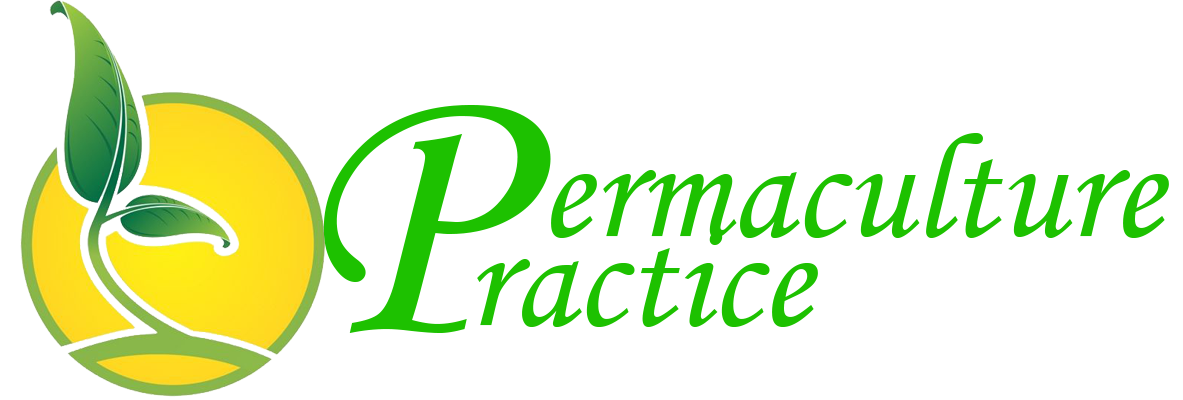Over 100,000 people in the United States have learned about permaculture. This shows that permaculture economic networks are growing. Permaculture helps us manage land and live sustainably, building strong economic networks.
By using permaculture, communities can become self-sufficient and protect the environment. This helps create a better economy for everyone. Permaculture, sustainable business, and a regenerative economy are key to a brighter future.
Permaculture combines water catchment, renewable energy, and waste recycling. It also focuses on food production. This makes it a powerful tool for sustainability.
The permaculture design is a global leader in sustainability. It draws from ecology and architecture. By focusing on permaculture, we can build a stronger, more sustainable economy.
Key Takeaways
- Permaculture economic networks are gaining momentum, with over 100,000 graduates having completed certificate courses in the United States.
- Permaculture principles can be applied to create economic networks that are resilient, self-sufficient, and environmentally friendly.
- Sustainable business models and regenerative economy are essential for creating a better future.
- Permaculture integrates systems such as water catchment, renewable energy, waste recycling, and food production into an efficient ecosystem design.
- Permaculture design methodology is considered one of the most effective for achieving sustainability globally.
- Community-based initiatives, such as farmers’ markets and community gardens, contribute to economic resilience by promoting local production and reducing dependence on global supply chains.
Understanding Permaculture and Its Principles
Permaculture is a way to manage land and live sustainably. It aims to build self-sufficient and strong communities. It started as ‘Permanent Agriculture’ and now is a full design philosophy for sustainable living.
At its heart, permaculture focuses on ecological design. It designs systems that work with nature, not against it. This method works in many places, from city flats to farms. It helps reduce environmental harm and makes using resources more efficient.
Permaculture is also linked to green entrepreneurship. This means using business ideas to make eco-friendly products and services. By mixing permaculture with green business, we can build strong, eco-friendly economies that help both people and the planet.
Definition and Core Concepts
The core of permaculture includes three main ethics: People Care, Earth Care, and Fair Share. These ethics help guide decisions and designs. They are key to building sustainable and resilient communities.
The Role of Sustainability
Sustainability is a big part of permaculture. It means designing systems that can last without harming natural resources. By using sustainable practices, we can lessen our environmental impact and help create a better world.
The Importance of Economic Networks in Permaculture
Permaculture economic networks are key to boosting community resilience. They support local food systems and encourage social permaculture. These networks cut down on global supply chain reliance, helping local economies thrive and supporting sustainable living.
These networks are great at building diverse communities. They make it easier to exchange goods and services. This helps communities become stronger and more resilient against economic and environmental issues.
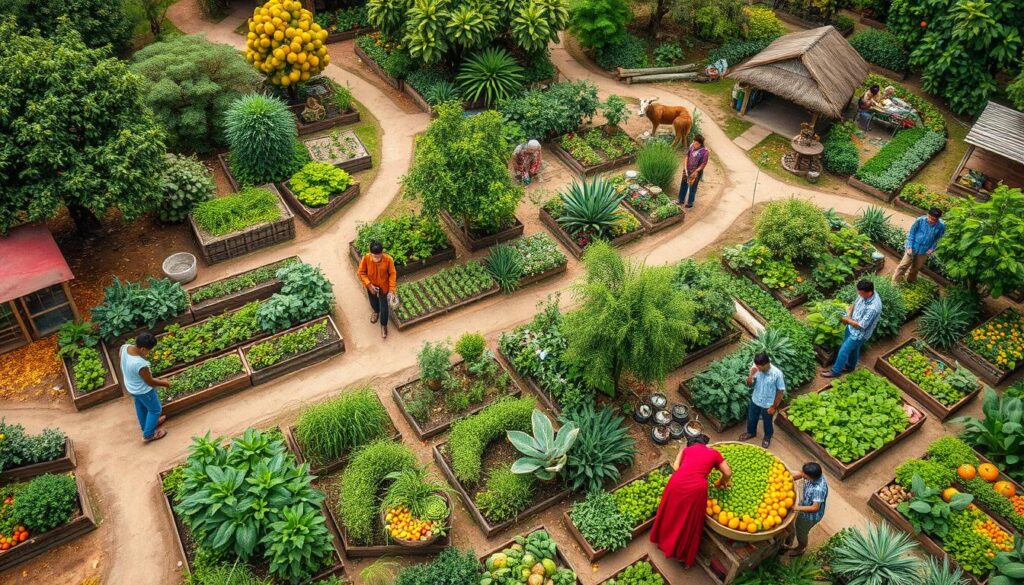
- Increased local food security
- Improved community engagement and participation
- Enhanced economic resilience and sustainability
| Benefits | Description |
|---|---|
| Local Food Security | Access to fresh, locally produced food |
| Community Engagement | Opportunities for community members to participate and contribute |
| Economic Resilience | Ability to withstand economic challenges and fluctuations |
Permaculture economic networks support local food systems and social permaculture. They help build a more sustainable and resilient future for communities.
Case Studies of Successful Permaculture Economic Networks
Permaculture economic networks have been a hit worldwide. They show how to build a regenerative economy. These networks use sustainable business models and focus on ecological design and community strength.
The Permaculture Institute of North America (PINA) is a great example. It supports education and sets professional standards. This helps grow permaculture networks in the area.
The Happy Food Farm in China is another success story. It grows most of its food itself. This farm shows how permaculture can make food systems sustainable and strong.
In Malawi, permaculture has helped families. It makes their farms more productive and secure. This shows how permaculture can improve lives.
Examples from the U.S.
In the U.S., many permaculture networks have done well. The Permaculture Association of the Northeast offers support and resources. The Regenerative Agriculture Foundation also promotes permaculture to make food systems better.
Global Success Stories
Worldwide, permaculture networks have built strong, sustainable communities. The Worldwide Permaculture Network lists 1,957 projects. These projects show how permaculture can tackle big issues like hunger and climate change.
| Project | Location | Description |
|---|---|---|
| Happy Food Farm | China | Self-sustaining farm growing fruits and vegetables |
| Permaculture Institute of North America | United States | Supports permaculture education and maintains professional standards |
| Worldwide Permaculture Network | Global | Features a database of 1,957 permaculture projects |
Key Components of a Permaculture Economic Network
A permaculture economic network is built on several key components. It works together to create a resilient and self-sufficient economy. At its core, this network relies on local food systems that promote sustainable agriculture. It also reduces reliance on external resources.
This approach is deeply rooted in ecological design. It aims to minimize the environmental impact of economic activities.
One of the critical aspects of a permaculture economic network is the involvement of local producers and consumers. By supporting local businesses and producers, communities can strengthen their economic base. This promotes green entrepreneurship.
This not only helps in preserving the local economy but also fosters a sense of community and cooperation.
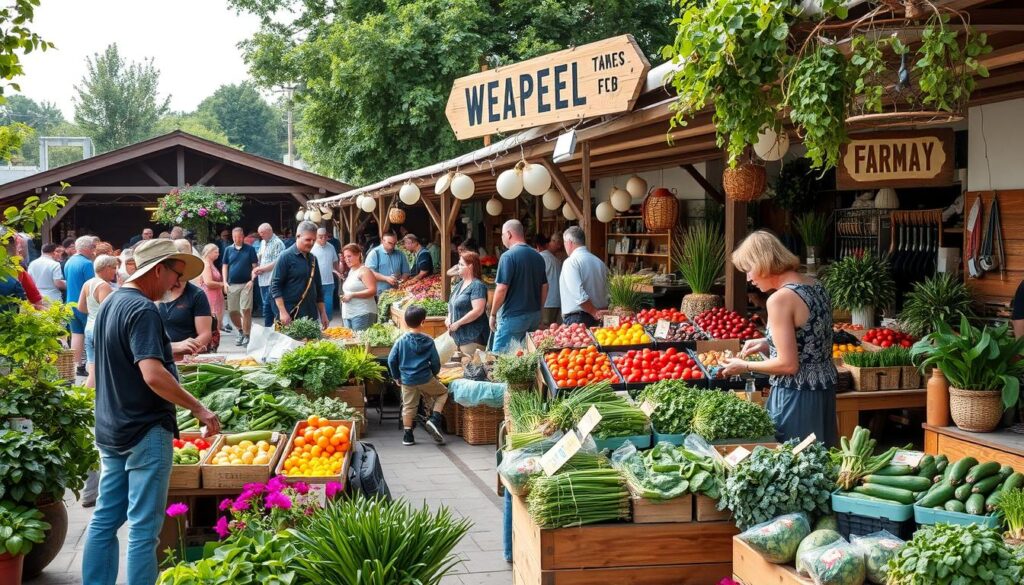
Also, resource sharing and bartering play a significant role in permaculture economic networks. These practices enable communities to make the most of available resources. It reduces waste and the need for external inputs.
Further, education and skill development are essential for the long-term sustainability of these networks. They equip community members with the knowledge and skills needed to maintain and improve their local economies.
| Component | Description |
|---|---|
| Local Producers and Consumers | Supporting local businesses to strengthen the economic base |
| Resource Sharing and Bartering | Optimizing resource use and reducing waste |
| Education and Skill Development | Equipping community members with necessary knowledge and skills |
Strategies for Building Economic Networks
Building economic networks needs a mix of community strength, social permaculture, and economic change. By working together, people and groups can build a better economy. This is done through urban permaculture like using green spaces and growing local food.
Technology and online platforms are key in building these networks. They help people talk, share resources, and work together. Social permaculture ideas, like helping each other, make online communities strong and united.
- Collaboration and partnerships among individuals and organizations
- Utilizing technology and digital platforms to facilitate communication and resource sharing
- Applying social permaculture principles to online interactions
- Fostering community resilience through education and skill-building initiatives
By using these strategies, we can build a better economy. One that values community strength, social permaculture, and economic growth.
Challenges Facing Permaculture Economic Networks
Permaculture economic networks face many challenges. These include market access and competition, as well as policy and regulatory barriers. These issues can slow down the growth of sustainable business models and regenerative economy projects.
Some major challenges are:
- Limited market access, making it hard for producers to sell their products
- Competition from conventional industrial agriculture, which is tough to beat
- Policy and regulatory barriers, which can hold back growth
To tackle these issues, permaculture economic networks can try new approaches. They can work together and use technology and digital platforms. This way, they can improve their market access and competitiveness. This helps in growing permaculture economic networks and regenerative economy projects.
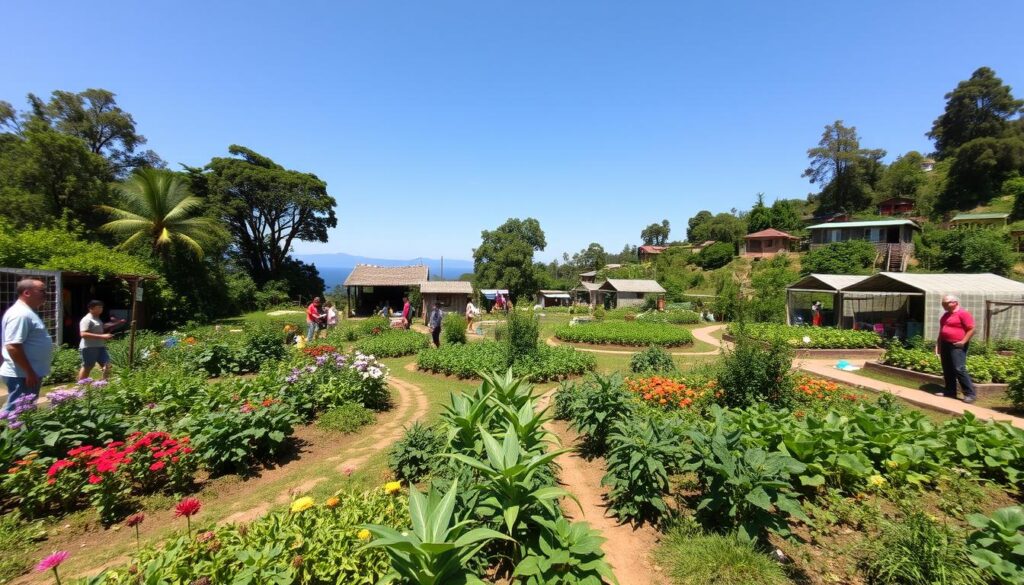
| Challenge | Description |
|---|---|
| Market Access | Limited access to markets, making it difficult for producers to sell their products |
| Competition | Competition from conventional industrial agriculture, which can be challenging to compete with |
| Policy and Regulatory Barriers | Policies and regulations that limit the growth and development of permaculture economic networks |
The Role of Community in Economic Networks
Building strong economic networks starts with community resilience. It lets people work together towards a common goal. Social permaculture helps by encouraging cooperation and support.
By bringing together different groups, communities can make their economy fairer and more inclusive. This helps everyone in the community.
Economic growth is linked to community development. When communities work together, they can find new ways to grow. This includes things like community-supported agriculture and local currencies.
Here are some ways to build community resilience in economic networks:
- Building trust and relationships among community members
- Engaging diverse stakeholders in the decision-making process
- Creating opportunities for economic cooperation and mutual support
By focusing on community resilience and social permaculture, economic networks can become better and fairer. This leads to a brighter future for everyone in the community.
The Impact of Permaculture Networks on Local Economies
Permaculture networks play a big role in local economies. They help with economic diversification and create jobs. By focusing on local food systems, they make local economies stronger and more independent. This is done by using local resources and reducing waste, thanks to ecological design principles.
Permaculture networks lead to new jobs in green entrepreneurship. This includes organic farming, sustainable forestry, and eco-tourism. They also help keep traditional skills alive while encouraging new ideas and businesses. Some important stats show the positive effects:
- 93% decrease in expenditures on seeds and plants due to local farmers sharing first-generation seeds
- £600 increase in annual income for families participating in permaculture projects
- 18% increase in job creation through diversified agricultural practices
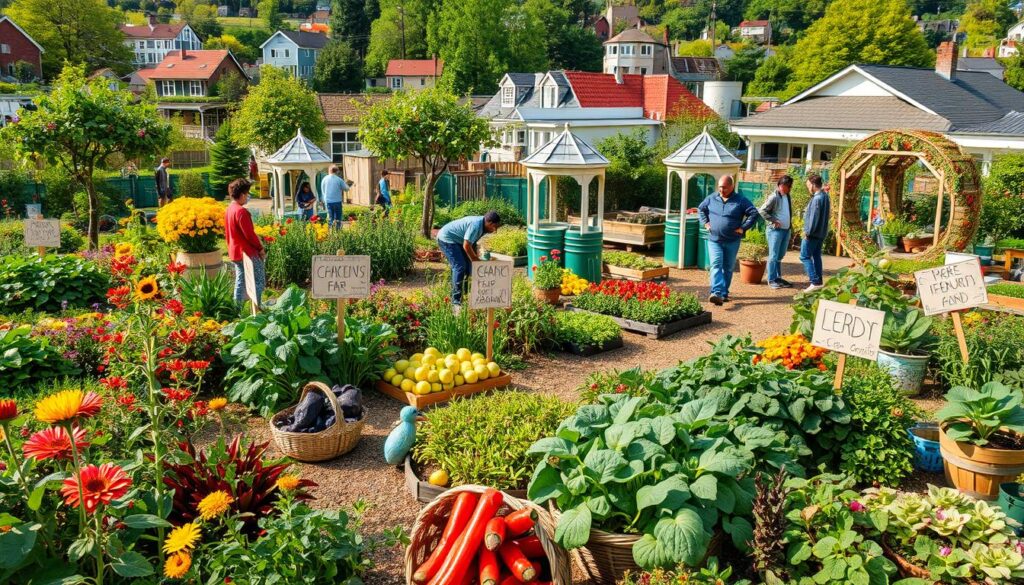
In summary, permaculture networks are key to a strong local economy. They support local food systems and green entrepreneurship. This leads to a more resilient and self-sufficient economy. It also promotes ecological design and keeps traditional skills alive.
| Category | Statistic |
|---|---|
| Economic Diversification | 18% increase in job creation |
| Job Creation | £600 increase in annual income |
| Ecological Design | 93% decrease in expenditures on seeds and plants |
Funding and Financial Support for Economic Networks
Permaculture economic networks need money to grow and succeed. Della Duncan, a Senior Fellow at the London School of Economics, believes in alternative economic models. These models help build a better economy.
To get the funds needed, permaculture networks can look into different options. This includes grants, public funding, crowdfunding, and community investment.
Here are some ways to get funding:
- Partner with groups that support green businesses.
- Make a solid proposal for grants and public funding.
- Get the community involved in crowdfunding and investment.
By using these funding methods, permaculture networks can help make our economy more sustainable. Richard Wolff says we need to change how we think about economics. This way, we can put people and the planet first, not just profit.
With the right funding, permaculture networks can help create a fairer and greener future.
| Funding Option | Description |
|---|---|
| Grants and Public Funding | Government and foundation grants that support sustainable business models and regenerative economy initiatives |
| Crowdfunding and Community Investment | Community-driven funding initiatives that support permaculture economic networks and sustainable business models |
Educational Initiatives to Foster Economic Networks
Building strong economic networks is key to community resilience. Workshops and training programs are vital in this effort. They focus on social permaculture, which aims to create harmony between nature and society.
Some important educational efforts include:
- Workshops on permaculture design and implementation
- Training programs for sustainable agriculture and renewable energy
- Online courses and resources for economic transformation and community resilience
These programs equip people with the skills for a resilient economy. They promote sustainability and fairness in economic systems. This is crucial for a better future.
The Permaculture Design Course (PDC) is a well-known program. It teaches participants how to design sustainable systems. Such education is vital for building strong economic networks.
| Initiative | Description |
|---|---|
| Permaculture Design Course (PDC) | A globally-recognized certification program for sustainable system design and implementation |
| Workshops and Training Programs | Hands-on training for sustainable agriculture, renewable energy, and economic transformation |
| Online Courses and Resources | Virtual learning opportunities for community resilience, social permaculture, and economic transformation |
Measuring the Success of Economic Networks
To see if permaculture economic networks work, we need to track important signs. These signs include how many people are involved, how much money is exchanged, and the community’s economic gain. By watching these signs, these networks can get better at their sustainable business models.
A study in Nepal shows the value of local knowledge in a regenerative economy. It found that permaculture helps farmers grow organic food better, increases crop yields, and brings social, environmental, and economic benefits. Permaculture economic networks can do the same, helping build a more regenerative economy.
Some important signs of success for permaculture economic networks are:
- How many people are involved and how much money is exchanged
- The economic benefits to the community
- Environmental gains, like less carbon emissions
- Social benefits, like more community involvement
By monitoring these signs and adjusting their plans, permaculture economic networks can support sustainable business models and a regenerative economy. They help solve big problems like food insecurity, which affects over 800 million people. Supporting local food systems and permaculture economic networks can lead to a more sustainable and fair food system.
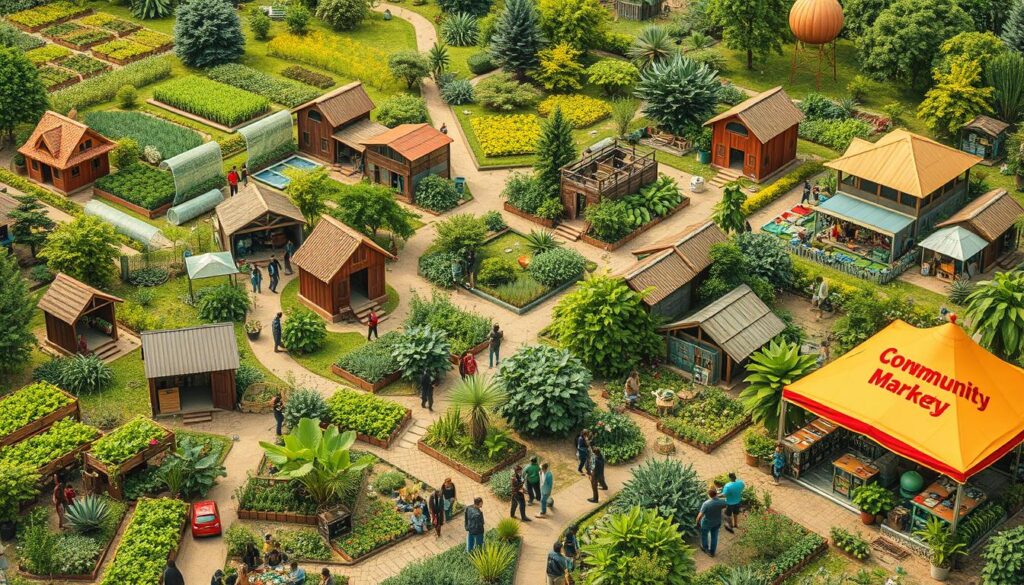
The success of permaculture economic networks relies on their ability to support sustainable business models and a regenerative economy. By setting and tracking key performance indicators, these networks can get better and have a bigger impact.
| Metric | Description |
|---|---|
| Number of participants | The number of individuals or organizations participating in the permaculture economic network |
| Economic impact | The overall economic benefit of the permaculture economic network on the community |
| Environmental benefits | The positive environmental effects of the permaculture economic network, such as reduced carbon emissions |
Future Trends in Permaculture Economic Networks
Looking ahead, permaculture economic networks will be key in building a stronger, self-sufficient economy. They use innovation and tech to drive economic transformation and boost community resilience. Andrew Millison, with over 20 years of experience, believes this shift is both necessary and inevitable.
Adopting social permaculture principles will be crucial. These principles focus on sharing and caring for the earth and people. The article The Future Up for Grabs highlights how this can lead to a more sustainable economy. Key strategies include:
- Using permaculture design principles like “observe and interact” and “catch and store energy”
- Encouraging a sharing economy and reducing waste
- Supporting local food and decentralized systems
By following these strategies, permaculture networks can lead to economic transformation and community resilience. As we face climate change and economic uncertainty, this approach is vital for a sustainable future.
Permaculture is a holistic approach to land management and sustainable living that offers solutions for building resilient economic networks.
Conclusion: The Path Forward for Permaculture Economic Networks
Permaculture economic networks are a bright spot for a greener future. They use permaculture’s key ideas like thinking big, recycling resources, and working together. This approach helps build strong local communities, supports many jobs, and grows a healthy economy.
Success stories show how permaculture businesses can change the game. They focus on caring for the planet, fairness, and being self-sufficient. With tech, teamwork, and community involvement, they’re showing what a strong local economy can be.
Now, it’s time for leaders, teachers, and community workers to keep pushing permaculture networks forward. We need money, training, and laws that help these networks grow. This way, we can help more places use permaculture to build a better, greener world.
